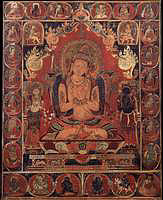
|
Bodhisattva Manjushri (painting no. 154)
|

View Larger Image |
||||||||||||||
|
Manjushri-ghosha (Tibetan: jam pal yang. English: The Glorious One with a Melodious Voice). Orange in colour, Manjushri has one face and two hands held to the heart in the Dharma Teaching gesture (mudra) delicately holding the stems of two lotus flowers blossoming at each ear. The blossom on his right supports the flaming sword of wisdom and the left supports the Prajnaparamita Sutra. Very peaceful and smiling, he is adorned with a crown, jewel and gold ornaments and variously coloured silk garments, seated in vajra posture above a moon disc, multi-coloured lotus and lion supported tiered throne. In front of the elaborate backrest, to the right and left, are two standing bodhisattvas, white and black, with the hands in the teaching gesture each holding a single lotus blossom supporting a moon and sun respectively. Still within the square enclosure, to the upper right and left of the backrest, are two bodhisattvas relaxing on bench seats. Along the top, from the left, is a Tibetan lama with the hands in the teaching gesture wearing monastic robes and a pandita hat. Next is the Buddha of Medicine (Sanskrit: Bhaishajyaguru), blue in colour followed by the buddha Shakyamuni flanked by two standing arhats. Next is the goddess Prajnaparamita, yellow in colour with four hands followed by the buddha of long-life, Amitayus, red, holding a vase and wearing a crown. Lastly, a householder lama with long hair holds the hands in the mudra of Dharma Teaching. Vertically along both sides are five seated lamas all with the hands in the teaching gesture, each hand holding the stem of a lotus and wearing monastic robes. All but one wear a pandita hat. Beneath them on the left is the wisdom deity White Achala (Tib.: me'o wa kar po) holding a sword and lasso, in a kneeling posture. On the right is Green Tara holding the stems of two blue lotus flowers, seated in a relaxed manner. Along the bottom from the left is the wrathful deity who removes disease, Bhurkumkuta (Tib.: me wa tseg pa), dark in colour, with three faces and six hands, standing in the flames of pristine awareness. Next is the wealth deity Ganapati, elephant faced, white in colour with four hands, seated in a relaxed manner. Next is Black Jambhala, deity of wealth, naked, holding a skullcup and mongoose, in a standing posture. Next is Panjara Mahakala with one face and two hands followed by a form of Mahakali Palden Rabtenma, black with two hands holding a sword and bag, riding a mule. At the bottom right corner is a solitary monastic figure most likely the patron of the artwork. Along with Avalokiteshvara and Tara, Manjushri is one of the most popular bodhisattvas and tutelary deity figures in Tantric Buddhism. Practiced in all schools, new and old, there are dozens of lineages, forms and variations of practice. For the Sarma Schools Manjushri is found in all four tantric classifications: Kriya, Carya, Yoga and Anuttarayoga. The most popular of those arise from the Siddhaikavira Tantra. Although no clear lineage characteristics can be found, it does however show a strong general Sakya influence based on the collection of secondary deity figures. In style the painting indicates a Nepali influence seen in the geometric layout, strong colours and detailed ornamentation striving not to leave any open canvas. J.Watt 7-98
|
|||||||||||||||
Photographed Image Copyright © 1998 Shelley & Donald Rubin Foundation
|
|
| |
Next Image |